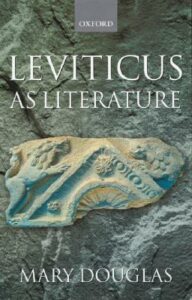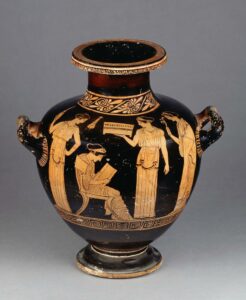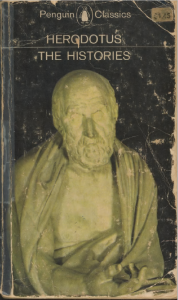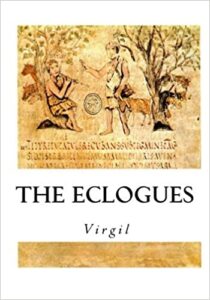 A question that for many years sat half-hidden, rarely if ever articulated, in the back of my mind — and no doubt in the minds of many readers with some awareness of ancient history: When did any culture in the ancient Levant start writing “books” as we would recognize them in, say, the first five books of the Old Testament?
A question that for many years sat half-hidden, rarely if ever articulated, in the back of my mind — and no doubt in the minds of many readers with some awareness of ancient history: When did any culture in the ancient Levant start writing “books” as we would recognize them in, say, the first five books of the Old Testament?
It turns out that this question is discussed in a couple of contributions to a volume addressing the anthropologist Mary Douglas‘s insights into the literary structure of the book of Leviticus: Reading Leviticus. A Conversation with Mary Douglas, edited by John F. A. Sawyer.
Now Leviticus is certainly constructed with very ancient — “pre-book” — stylistic features, in particular, the “ring composition”. As Douglas explains:
In Leviticus’ favourite literary form, chiastic composition, the meaning is at the pivot or the middle of a series of parallel verses. On either side of the sections on leprosy there stand supporting verses on human reproduction like steps or like framing pillars. Within the series on a leprous person, two additional afflicted objects are introduced, a leprous garment, and a leprous house. The alternation makes an a–b–a–b pattern as follows:
a Leprosy of a person, diagnosis, 13: 1–46
b Leprosy of a garment, diagnosis, 13: 47–59
a′ Leprosy of a person, declaring clean and atonement, 14: 1–32
b′ Leprosy of a house, diagnosis and cleansing, atonement, 14: 47–53When body, garment, and house are found in a carefully constructed set of rules, we have been warned. It signals a return to the body/temple microcosm. The reading is also returned to the early conceit of the ‘house-that-Jack-built’, the concentric pattern of one thing placed upon another and another. (p. 177)
An old technique for creating focus is to set up a series of concentric circles. Leviticus frequently places parallel cases in ascending order, so that the last includes the second and the second includes the first. They can be run backwards or forwards with the closure at either end. It is a very ancient formula. In Mesopotamia in the classical period, 2000 to 1500 BCE, the following magic incantation was recommended to wash a mote out of the eye:
Earth, they say, earth bore mud,
mud bore stalk,
stalk bore ear,
ear bore mote, . . .
the mote entered the young man’s eye.
A modern Hebrew example of concentric incorporation is the old doggerel recited by the children at the Passover ceremony:
Only one kid, only one kid, which my father bought for two zuzim . . .
And a cat came and ate the kid, which my father bought for two zuzim; only one kid, only one kid.
And a dog came and bit the cat which ate the kid, etc.
And a stick came and beat the dog which bit the cat which ate the kid, etc.The English parallel is ‘The House that Jack Built’, which ends with a grand inclusive finale:
This is the stick that beat the dog, that bit the cat, that killed the rat, which ate the grain which lay in the house that Jack built.
Leviticus applies something very like this literary trope in a slow and measured fashion to the layers inside the body of a living being, and also to the body’s outer coverings. . . . (p. 54)
So Leviticus does in one sense remind readers of the earliest written compositions such as poetic epics that employed “ringing” or “concentric circle” techniques that were apparent aides to memory for oral performance. The term parallelism has been coined to discuss this very ancient and universal technique:
So far from being a local Semitic style, parallelism also governs the form of millennia-old Chinese poetry [Zongqi] and is found in oral literature throughout the world [Fox]. (p. 48)
We cannot deny that Leviticus is marked with some very ancient techniques. But it is still unlike any other “book” from very ancient times. It is not like an epic poem or list of proverbs that was constructed with such parallelism to assist the memory of the reciter.
Rolf Rendtorff responds to Mary Douglas’s analysis of Leviticus by delineating the characteristics that make it a standalone “book” even though it contains thematic links binding it to the other four books of the Pentateuch. It is a self-contained narrative about the Jerusalem cult and it is made up of a coherent structure, beginning, end, and middle, with the various parts threaded together with structures, themes and images that make it an organic whole.

Kathryn Gutzwiller continues Rendtorff’s discussion but her contribution is as a classicist, an outsider to biblical studies. For Gutzwiller it is important to distinguish the employment of ring composition from the creation of a book per see.
. . . I find another distinction to be necessary as well, one that separates the process of ring composition from the concept of the book.
In modern terms, the word ‘book’ has two different meanings that seem relevant to the topic at hand. The word refers to a physical entity, to pages bound in a volume, but a book is also an intellectual concept, that which is composed to be read as an integrated unit. While the physical entity and the intellectual construct normally correspond, this is not always the case, so that we may have a long book published in two or more volumes, each a ‘book’ in the physical sense. A similar situation prevailed in the ancient world. . . . Books in [the physical] sense existed in Greece at least as early as the beginning of the sixth century, a period of time when the Greeks had extensive contacts with Egyptian culture.
So when did books “in the intellectual sense” begin to appear?
The point at which the Greeks began to compose texts to fit upon a papyrus roll, and so to be books in both senses of the word, is difficult to determine. In all likelihood, the rise of prose literature in the late fifth century is connected with this phenomenon. (p. 37)
We easily think of Herodotus, the historian. Kathryn Gutzwiller suggests Herodotus was a transitional figure. Yes, he wrote an extensive history in prose, but we also know that there were oral presentations of portions of his Histories.
Soon afterwards we have the historian Thucydides who would have none of Herodotus’s popular “tricks”. His work, he announced in his opening, was not a pop piece to entertain for a moment but rather a monument to last forever.
I have written my work, not as an essay which is to win the applause of the moment, but as a possession for all time. (1.22.4)
Books — in both the physical and intellectual sense — began to appear in the Hellenistic era, explains KG:
Yet the process of gathering and organizing Greek literature, of editing it into divisions or ‘books’ that were coextensive with papyrus scrolls, did not begin in earnest until the first half of the third century. At that time the Ptolemaic monarchs in Alexandria set out to acquire all literary texts in their manifold variations and commissioned leading textual scholars to establish authoritative editions. Earlier Greek poetry was ordered in accordance with whatever principles seemed appropriate (e.g., by occasion of performance, meter, or alphabetically) and then divided into books on scrolls that were numbered sequentially. As a result, the Greeks became accustomed, in the course of the third century, to think of a book in an intellectual sense, not just as a physical entity. From the second century, for instance, there are papyri containing two ‘books’ of Homer on a single roll; they are conceived separately as books in the thematic sense but are bound together physically for ease of transmission. (p. 37)
Ring composition’s disappearance from the book
 Ring composition, as we have seen, is by far much older than “books”. Recall that KG suggested Herodotus was a transitional figure and this literary structure is another indicator of that status. Herodotus followed the tradition of the poets by utilizing the traditional ring structure for smaller narrative units:
Ring composition, as we have seen, is by far much older than “books”. Recall that KG suggested Herodotus was a transitional figure and this literary structure is another indicator of that status. Herodotus followed the tradition of the poets by utilizing the traditional ring structure for smaller narrative units:
In the epic compositions of Homer and Hesiod, relatively small narrative units are commonly organized in a ring, while larger structures, like the Iliad as a whole, have also been analyzed on the same pattern. As a basic method of organizing thought throughout the archaic period (and before as well, one assumes), ring composition apparently helped the oral composer remember and structure narrative units and helped the audience to comprehend them in a performance setting. This form of compositional structure continues to be a dominant mode of organizing discourse down through the time of Herodotus, who often forms his larger narrative units in rings with the moral lesson at the center, or pivotal point. In narrating the fall of Lydia in Book 1, for instance, he places Croesus’ misinterpretation of Apollo’s oracles—the king’s all too human mistake—at the turning point of his ring (1.46-56).
But then came the “intellectual paradigm shift” for which the Greeks are famous.
In the latter years of the fifth century, ring composition came to be replaced with other forms of organization we tend to associate with rational or logical thinking, such as linear, chronological narrative or arrangement by type and subtype. The demise of ring composition was connected with the intellectual paradigm shift that took place under the influence of sophistic and Socratic thinkers, who replaced traditional modes of thought with an emphasis on definition and rational argument. (p. 38)
 Enter Thucydides’ strictly chronological account and Aristotle’s topic-methodical prose. Ring compositions do make a come-back but as “artistically contrived poetry” such as in Virgil’s Eclogues. The point appears to have been to self-consciously imitate the most archaic styles. There is a giveaway in the remaining manuscripts that lead us to this conclusion, that the use of ring composition was an imitation of a style no longer part of the literary ethos of the day:
Enter Thucydides’ strictly chronological account and Aristotle’s topic-methodical prose. Ring compositions do make a come-back but as “artistically contrived poetry” such as in Virgil’s Eclogues. The point appears to have been to self-consciously imitate the most archaic styles. There is a giveaway in the remaining manuscripts that lead us to this conclusion, that the use of ring composition was an imitation of a style no longer part of the literary ethos of the day:
[T]his … disappearance of ring composition as a dominant manner of thought … accounts for the absence of any discussion of it in the rhetorical and literary critical treatises of the Hellenistic and Roman periods. (p. 39)
How all of this helps with dating Leviticus
So we have a book, Leviticus. (It has always been referred to as one of the five books of the Torah, using the Greek biblos for book and the Rolf Rendtorff demonstrated that it is indeed an “intellectual” book and not only a “physical” one. Yet it clearly is structured with an archaic technique of rings. Here is Kathryn Gutzwiller’s conclusion:
How does this correspondence [book + ring structure] help us with dating the text as we now have it and with understanding the circumstances of its creation? Although cultural parallels are inexact and somewhat perilous, I would argue it very unlikely that in matters of literary composition the ancient Hebrews were more advanced than their Greek neighbors. If Herodotus’ Histories is taken as an appropriate parallel, it may be assumed that Leviticus became a fixed text at a time when traditional methods of composition were being incorporated into texts that were designed to be preserved in written form. In Greece this process dates to the fifth century, so that Douglas’s dating of Leviticus to the postexilic period seems the earliest possible date. Since techniques of oral composition, including ring structures, have been identified even in books of the New Testament, there remains a very real possibility that Leviticus was given final form, especially in its relationship with other books of the Pentateuch, at a somewhat later date. (p. 39)
Douglas, Mary. Leviticus As Literature. International Edition. Oxford; New York: Oxford University Press, 2001.
Gutzwiller, Kathryn. “Comments on Rolf Rendtorff.” In Reading Leviticus: Responses to Mary Douglas, edited by John F. A. Sawyer, 36–39. A&C Black, 1996.
Rendtorff, Rolf. “Is It Possible to Read Leviticus as a Separate Book?” In Reading Leviticus: Responses to Mary Douglas, edited by John F. A. Sawyer, 22–35. A&C Black, 1996.
If you enjoyed this post, please consider donating to Vridar. Thanks!

When one is trying to write a theological backstory for a people, would not one adopt an older style so that the story is perceived as being ancient? Were authors capable of writing thus? Are their known fictions that use archaic styles to create mood, for example?
The New testament uses repeatedly quotes from the Old testament to create mood.
Diaries of two participants in the Trojan War, Dares and Diktys, were written in the bland war-commentary style one would expect of lowly participants, and as a result convinced educated elites for centuries that they were genuine. It was because they were realistically and naturalistically (no gods involved) narrated that they were deemed to be genuine works from the war 800 years or so earlier.
A novel about a lowly shepherd and shepherdess, Daphnes and Chloe, was told in the simple style one would find appropriate for such rustics.
There was a strong emphasis on the importance of imitating “the masters” like Homer, yet with imaginative variation so as not to be merely slavish imitators. And sometimes archaic styles were used by poets simply for the sake of ornate prettiness. (Authors can also imitate styles just for personal fun — e.g. Dylan Thomas wrote a multi-page poem in which the final words of the first and last lines rhymed, then the final words of the second and second last words rhymed, and so on — no listener, nor even reader, is going to notice that until they get to the very middle where they see the only couplet and perhaps begin to notice something else in the adjacent lines, etc.)
As Russell Gmirkin has pointed out, Plato called for the creation of a foundation myth in an ideal society that gave all the appearance of being a very ancient myth in order to establish awe and a sense of authenticity.
Mahayana Buddhist texts use the opening formulae (and maybe the closing formulae) from older Buddhist scriptures in order to make readers believe that they are reading Buddhvacana (authentic Buddhist teachings).
The 5th-century BC Aramaic story Words of Ahikar is full of sayings and proverbs, many similar to local Babylonian and Persian aphorisms as well as passages similar to parts of the Book of Proverbs and others to the deuterocanonical Wisdom of Sirach.
Very thought provoking and helpful, thanks, Neil.
The value of understanding late Pentateuch is being able to then explain how the Temple dissenters who became groups like the Qumran community could have formed some of their theology out of a recent memory of Jewish beliefs that were suppressed by the creation of scripture.
In particular, astrology, human sacrifice and its connection to Pauline messianism (which the Qumran community may have originated – creating the theology of a martyred teacher whose death provokes global spiritual consequences).
This also explains the perceived sudden genesis of Gnosticism, which may be related to the belief systems which the Pentateuch suppressed. An entire history of a belief system erased and overwritten.
Finally, context that very helpfully explains the evolution of early Christianity and rabbinical Judaism. In my opinion, a very large percentage of Jews – post-Revolt – were converted to the post-Qumran beliefs which rejected Yahweh as a corrupted deity. The Temple was destroyed, the world had to be destroyed with its peoples slaughtered (Kitos War), and the Temple with the World would be rebuilt by the two messiahs in Heaven and on Earth.
It seems that this violent, radical messianic Judaism – incorporating Jewish theology from before the Pentateuch – in being crushed by Rome, led to a fallout that includes the formalization of pacifistic Gnosticism, Christianity and rabbinical Judaism. I would speculate that a Kitos War messianic Judaism is something of a lost religion or missing link that explains what comes after. Our historical amnesia about it is why we don’t see any real evidence of what’s going on until the third century. This isn’t a phantom religion, it’s strongly hinted at in the Dead Sea Scrolls.
If we can say that there was a robust Jewish theology, which looked a lot more like its Canaanite and Syrian neighbors, which the Pentateuch deliberately redacted in order to be more respectably Hellenic, then we have a much stronger explanation for the novel theology in the Dead Sea Scrolls, and more of a reason to assume a more widespread acceptance of this non-Mosaic Judaism among first and second century Jews.
Atargatis as the Queen of Heaven mother of Icthys, worshipped at Ashkelon and Edessa, and Zebedee being a “fisherman” simply can’t be ignored. If we recognize rabbinical Judaism as not necessarily older than Christianity itself, then we can explain Christian origins by rejected the historical narrative of the Old and New Testament as a contemporaneous (relatively) redaction. I think it’s no coincidence that the only places where there’s convergence is within the scope of Josephus’s histories, which seem to be the only which have survived. We can also pinpoint Josephus as a key collaborator in whitewashing Jewish history so that the Old and New Testaments are able to stand as remotely credible from a historical basis.
The grand finale of “the house that Jack built” is
“This is the horse and the hound and the horn
That belonged to the farmer sowing his corn
That kept the rooster that crowed in the morn
That woke the judge all shaven and shorn
That married the man all tattered and torn
That kissed the maiden all forlorn
That milked the cow with the crumpled horn
That tossed the dog that worried the cat
That chased the rat that ate the cheese
That lay in the house that Jack built.
In one version, at least.
I note that the discussion about when books started completely ignores books in India and China.
Cobbling together a new religion at the same time others were doing the same:
While Ptolemy I Soter founded the imperial cult of Alexander, his son and successor Ptolemy II completed its connection to the ruler cult around the reigning dynasty itself. The cult of the Ptolemies began in 283/2 BC, when the deceased parents of Ptolemy II were deified as the “Saviour Gods” (θεοὶ σωτῆρες, theoi sōtēres). Statues of the deified couple were installed in the Temple of Alexander, and the priest of the Alexander cult took over the rites for the deified Ptolemies as well. With this gesture, the Ptolemies underlined the superior position of Alexander, and their own subordination to him as “temple-sharing gods” (σύνναοι θεοί, synnanoi theoi). Alexander remained the main recipient of rituals and sacrifices, with the Ptolemies only partaking in them.
The elevation of Alexander over the Ptolemies, and their connection to him, was further deepened through the expansion of the cult. Thus in 269 BC, the female priestly office of “basket bearer” (kanēphóros) for the “Sibling Goddess” (thea adelphos) Arsinoe II was established, followed in 211 BC by the “prize-bearer” priestess (athlophoros) in honour of the “Benefactor Goddess” (thea euergetis), Berenice II, and in 199 BC by a priestess for the “Father-Loving Goddess” (thea philopatōr), Arsinoe III. All these priesthoods were subordinate to the priest of Alexander.
https://en.wikipedia.org/wiki/Ptolemaic_cult_of_Alexander_the_Great
Bit like the family of ‘dearly great leaders’ in North Korea today.
“In artistic depictions, Ptolemy II was often depicted with divine attributes, namely the club of Heracles and the elephant-scalp headdress associated with Alexander the Great, while Arsinoe was shown carrying a pair of cornucopiae with a small ram’s horn behind her ear.” Here is Heracles alive and well guarding Buddha with his club: https://en.wikipedia.org/wiki/Heracles#/media/File:Buddha-Vajrapani-Herakles.JPG They say the first Buddha statues are actually a Greco-Bactrian king in deified form but perhaps they themselves were imitating Ptolemy II.